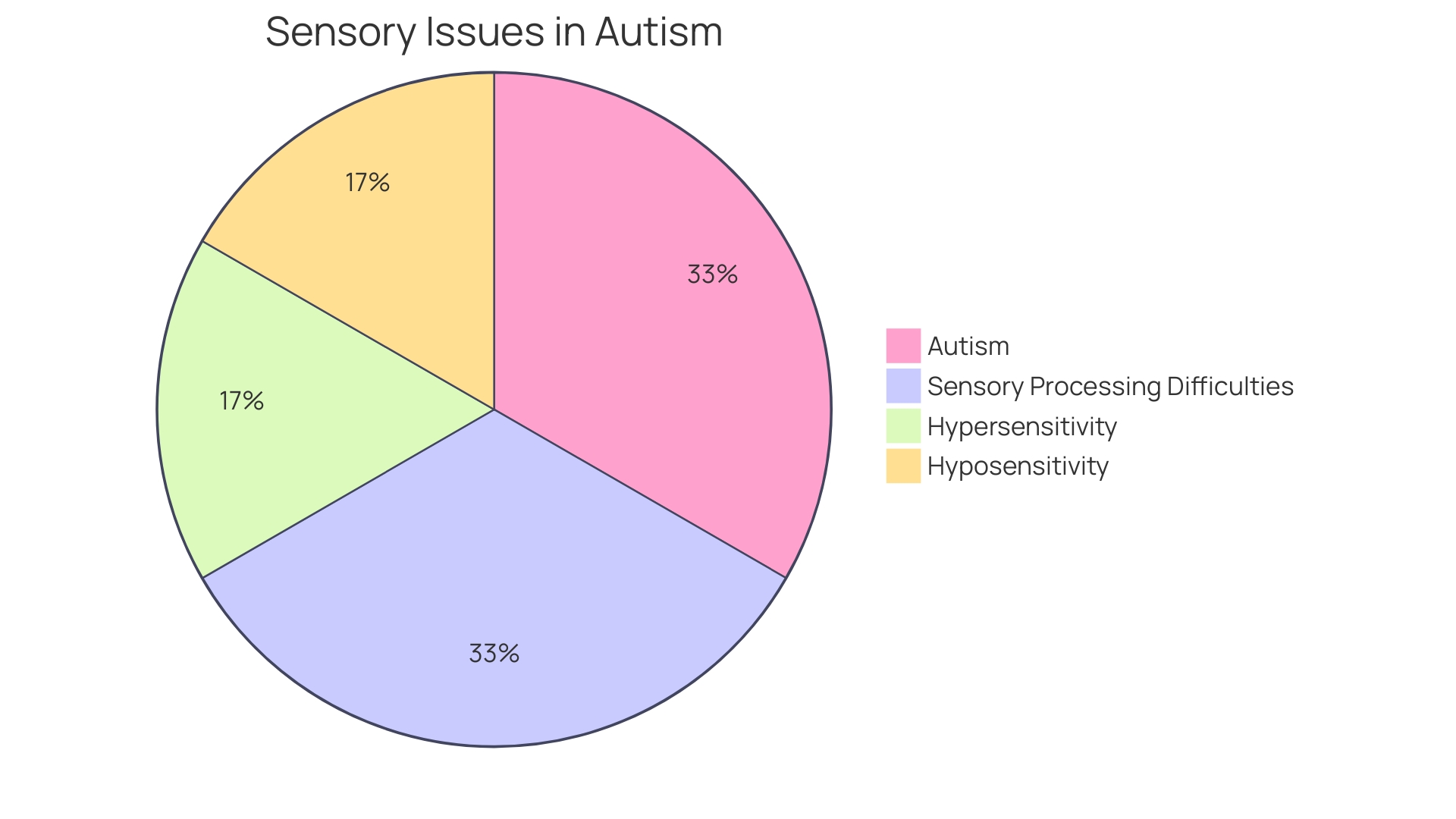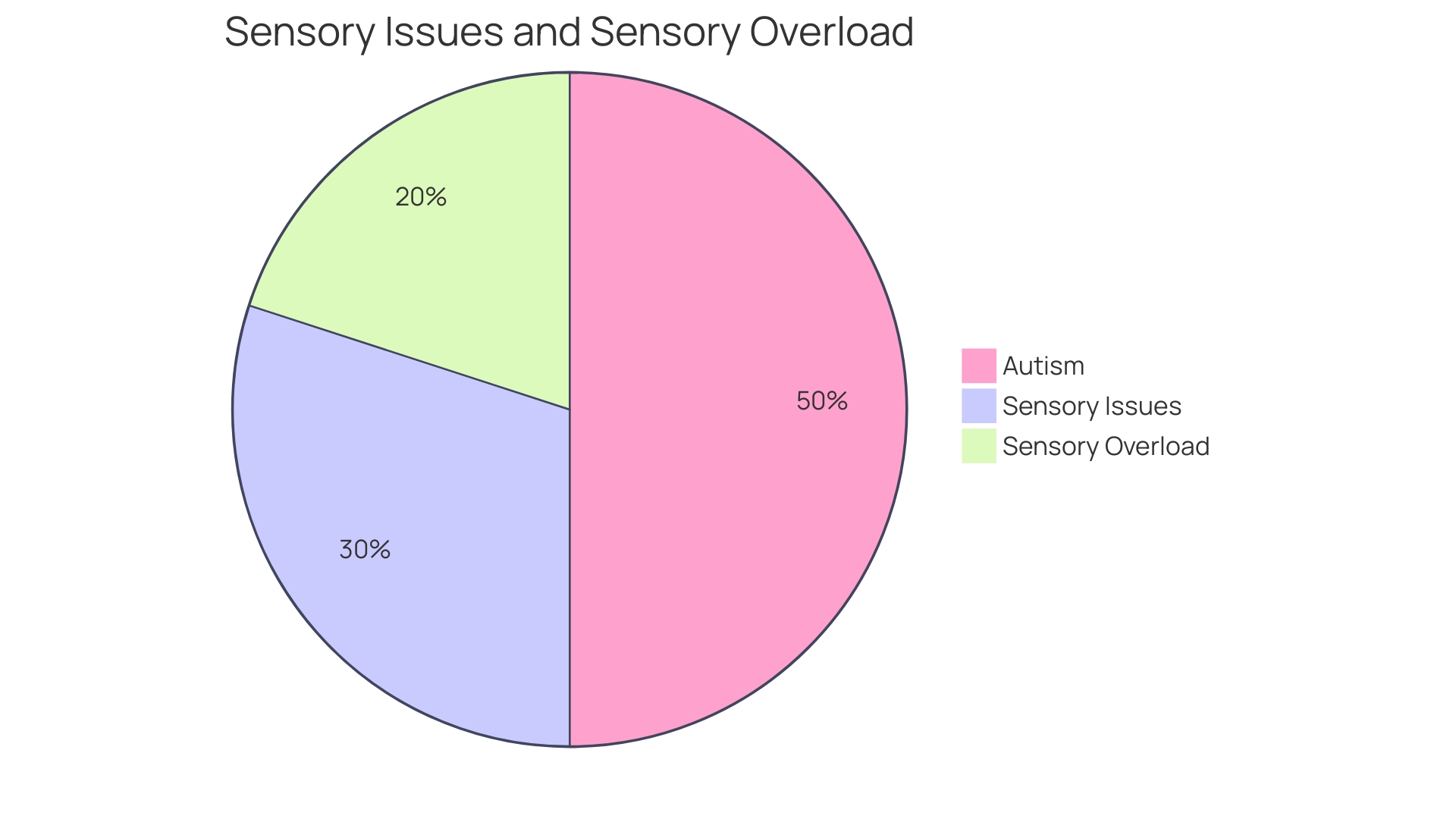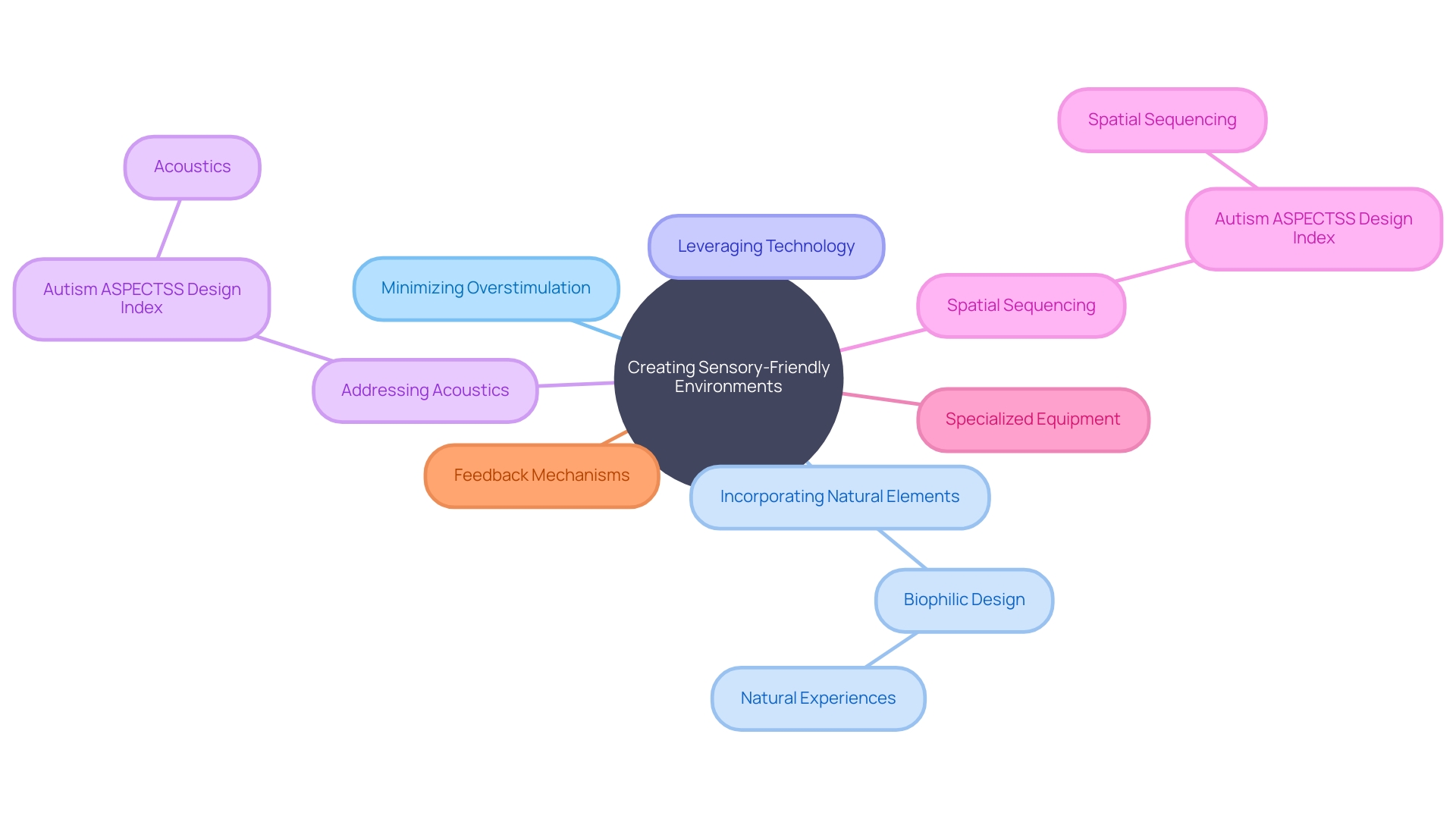Introduction
Understanding and supporting sensory needs is crucial for the well-being of neurodivergent individuals. Sensory processing, which encompasses various senses beyond the traditional five, plays a significant role in how individuals with unique neurobehavioral profiles experience and navigate the world. For parents and caregivers, gaining insight into sensory experiences is essential for creating environments that promote comfort and engagement.
This is particularly important for individuals with conditions such as Autism Spectrum Disorder (ASD), who often face sensory processing challenges that can manifest as hypersensitivity or hyposensitivity. The ability to articulate these sensory issues can be challenging, especially for children who may struggle to describe their experiences. However, innovative solutions are emerging, such as augmented reality (AR) applications that transform tactile sensations into visual and auditory cues, aiming to alleviate distress by catering to individuals' sensory preferences.
The prevalence of neurological conditions globally underscores the significance of understanding and supporting sensory needs as part of broader efforts to enhance the lives of those affected. Collaboration, communication, and accessible news distribution services play crucial roles in advancing research, services, and accessibility technology for neurodivergent individuals. Strategies to navigate open spaces, recognizing specific sensory triggers, and implementing coping mechanisms can greatly improve the quality of life for neurodivergent individuals.
By embracing neurodiversity and fostering inclusive environments, we can create spaces where everyone has the opportunity to thrive. With a combination of personalized strategies, supportive technologies, and ongoing research and advocacy, we can ensure that every individual can navigate their environment with confidence and ease, ultimately leading to a more empathetic and adaptive society.
Understanding Sensory Needs
Grasping the nuances of sensory needs is vital for nurturing the growth of individuals with unique neurobehavioral profiles. Sensory processing encompasses the traditional five senses as well as the lesser-known proprioceptive and vestibular senses, governing body awareness and equilibrium respectively. Deepening our insight into these sensory experiences enables parents and caregivers to curate environments that foster their child's comfort and engagement.
For instance, individuals with Autism Spectrum Disorder (ASD) often encounter sensory processing challenges, which can manifest as either hypersensitivity or hyposensitivity across various stimuli. This can include reactions to everyday sights, sounds, tastes, smells, and physical sensations, such as touch or awareness of one's own body in space. These sensory issues are not always easy to articulate, particularly for children who may lack the vocabulary to describe their experiences.
Innovative solutions are emerging to assist with these sensory sensitivities. One such approach involves the development of an augmented reality (AR) application designed to transform tactile sensations into visual and auditory cues. This technology targets key moments of discomfort, such as the tactile sensitivity experienced when a patient sits in a dental chair or walks down a narrow hallway, aiming to alleviate distress by catering to the individual's sensory preferences.
Statistics underscore the prevalence and impact of neurological conditions globally. Over three billion people were living with a neurological condition in 2021, signifying the leading cause of disability and ill health worldwide. These figures highlight the importance of understanding and supporting sensory needs as part of broader efforts to improve the lives of those affected.
The Interagency Autism Coordinating Committee (IACC) emphasizes the need for collaboration and communication within the federal government and the autism community to advance research and services. Moreover, accessible news distribution services like the AT-Newswire Press Release News Distribution Service ensure that information regarding accessibility technology reaches a wide audience, including those with neurodivergent conditions.
Strategies to navigate open spaces, such as identifying specific sensory triggers and implementing coping mechanisms, can greatly enhance the quality of life for neurodivergent individuals. Recognizing the diversity in how people's brains function and interact with the world around them is part of embracing neurodiversity and fostering inclusive environments.
In conclusion, understanding and supporting sensory needs are integral to the well-being of neurodivergent individuals. With a combination of personalized strategies, supportive technologies, and ongoing research and advocacy, we can create spaces where everyone has the opportunity to thrive.
The Impact of Sensory Processing Challenges
For individuals with neurobehavioral challenges, such as those on the autism spectrum, the world can often seem like an unpredictable and overwhelming place. Sensory processing, an integral part of daily functioning, can be disrupted, leading to a heightened state of anxiety and distress. The perception of everyday sensory stimuli, which many of us take for granted, can vary dramatically. Some may experience intense sensitivity to environmental cues like the hum of a fluorescent light or the feel of certain fabrics, a condition known as hypersensitivity. Conversely, others may exhibit hyposensitivity, where the sensory input is not adequately detected or processed.
Understanding these sensory processing differences is crucial for parents and caregivers to create supportive environments. Innovations in technology offer promising solutions, such as the development of an augmented reality (AR) application designed to transform tactile sensations into visual and auditory signals. This tool caters to the unique sensory needs of individuals with autism by providing alternative ways to process stimuli during potentially stressful situations, such as a dental visit.
Autism, a condition affecting an estimated 1 in 36 children, can manifest through a diverse range of sensory sensitivities, including visual, auditory, taste, smell, balance, touch, proprioception, and interoception. A deep understanding of these sensitivities is essential for supporting neurodivergent individuals in various settings, from home to the classroom, and into the workforce.
As we strive for a more inclusive society, initiatives are underway to train businesses to become more accessible and welcoming to autistic individuals. This approach not only benefits those with sensory processing differences but enriches our communities by embracing neurodiversity. With over 3 billion people worldwide living with neurological conditions, the need for such inclusive practices has never been more apparent.
Neurodiversity in the workplace also highlights the significance of accommodating the needs of neurodivergent employees. Considering their unique perspectives and skills, it's essential to identify specific sensory triggers that may be overwhelming and develop strategies to mitigate their impact. This not only fosters a more inclusive environment but also enables neurodivergent individuals to thrive professionally.
Through a collective effort to understand and support sensory needs, we can ensure that every individual has the opportunity to navigate their environment with confidence and ease, ultimately leading to a more empathetic and adaptive society.

Recognizing Sensory Signals
Understanding sensory signals is vital for supporting individuals with sensory processing challenges. When a person has difficulty processing sensory input, they may display various cues or behaviors indicative of their discomfort. For instance, some might cover their ears or eyes to block overwhelming stimuli, while others may shy away from touch or become irritable in loud settings. Conversely, certain individuals may actively seek out specific sensory experiences to fulfill their sensory needs. Recognizing these signals is essential for parents and caregivers to provide appropriate support.
Individuals with Autism Spectrum Disorder (ASD), for example, can face sensory processing difficulties, manifesting as either hypersensitivity or hyposensitivity to stimuli like sights, sounds, tastes, smells, balance, touch, and even internal body cues. A young child named Adleigh Barlow exhibited signs early on when she held books close to her face, showing a visual processing difference. Similarly, a new medical facility in Philadelphia acknowledges the importance of a sensory-sensitive environment by integrating calming design features to ease the stress of neurodiverse individuals, like those with autism and ADHD.
Moreover, advancements in technology offer innovative solutions to sensory challenges. An AR application was prototyped to transform tactile sensations into visual and auditory signals, catering to individuals who might find the texture of a dental chair or the vibration of a drill distressing. Such initiatives demonstrate a growing awareness and accommodation for sensory sensitivities.
Dr. Temple Grandin, a renowned advocate for the autism community, emphasizes the significance of creating environments that consider sensory sensitivities. For example, she advises using non-flickering LED lights to avoid discomfort. This kind of thoughtful design can be a game-changer for those sensitive to particular sensory inputs.
Recent statistics reveal a rise in disability rates among Canadians, with mental health-related disabilities seeing a significant increase among youth and working-age adults. The 2022 Canadian Survey on Disability indicates that 27% of Canadians aged 15 years and older experience disabilities that impact their daily activities. This data underscores the critical need for understanding and supporting sensory needs across various populations.
By paying close attention to these signals and creating accommodating spaces, we can better support those with sensory needs, allowing them to thrive in a world that acknowledges and respects their unique sensory experiences.

Creating a Sensory-Friendly Environment
A sensory-friendly environment, tailored to individual needs, is not just a thoughtful inclusion but a necessity for neurobehavioral development. It requires a delicate balance of minimizing overstimulating elements and introducing supportive sensory experiences. For example, the use of natural experiences, as endorsed by biophilic design principles, can have a profound impact on sensory regulation. Incorporating direct sensory connections with nature, such as plants, water features, or natural lighting, can vastly improve the quality of life for neurodivergent individuals.
Designing for the sensory needs of individuals is a multifaceted approach that draws on insights from neuroaesthetics, with a focus on creating spaces that foster a sense of belonging, transformation, and community. A prime example of this is the innovative use of augmented reality (AR) to transform tactile sensations into visual and auditory stimuli, making environments more accessible to those with heightened sensitivities.
Moreover, the Autism ASPECTSS Design Index highlights the importance of acoustics and spatial sequencing in creating environments that address the unique challenges faced by individuals on the autism spectrum. By considering these aspects, environments can become more predictable and comforting, reducing distractions and enhancing focus.
In educational and healthcare settings, such as the work done with MSU Museum exhibits, technology is leveraged to address visitors' sensory preferences and navigation needs. Similarly, the Sensory Well-being Hub at Lane Tech College Prep High School exemplifies how spaces can be crafted to support proprioceptive and vestibular system dysfunctions with specialized equipment and feedback mechanisms.
The design of the Honickman Center in Philadelphia is another testament to the importance of sensory-friendly environments, where calming design features and nature scenes create a less stressful experience for neurodiverse visitors. This forward-thinking approach to behavioral health design is not only sustainable but also crucial for improving the well-being of individuals with sensory sensitivities.
In summary, creating a supportive and comfortable space for individuals with sensory needs involves an informed blend of reducing overwhelming stimuli and providing engaging sensory activities, all while drawing on the latest research and technological advancements to ensure every individual can thrive in their environment.

Conclusion
Understanding and supporting sensory needs is crucial for the well-being of neurodivergent individuals. By gaining insight into sensory experiences, parents and caregivers can create environments that promote comfort and engagement. Innovative solutions, like augmented reality (AR) applications, cater to sensory preferences and alleviate distress.
Embracing neurodiversity and fostering inclusive environments allows everyone to thrive. With personalized strategies, supportive technologies, and ongoing research and advocacy, we can ensure that every individual can navigate their environment with confidence and ease, leading to a more empathetic and adaptive society.
Recognizing sensory signals is vital for supporting individuals with sensory processing challenges. Understanding these signals enables appropriate support. Innovations like AR applications that transform tactile sensations into visual and auditory signals offer alternative ways to process stimuli in stressful situations, benefiting individuals with sensory sensitivities.
Creating a sensory-friendly environment tailored to individual needs is essential for neurobehavioral development. By minimizing overstimulating elements and introducing supportive sensory experiences, we vastly improve the quality of life for neurodivergent individuals. Incorporating nature connections and leveraging technology enhances sensory regulation and makes environments more accessible to those with heightened sensitivities.
In conclusion, understanding and supporting sensory needs are integral to the well-being of neurodivergent individuals. With personalized strategies, supportive technologies, and ongoing research and advocacy, we can create inclusive spaces where everyone can thrive. Recognizing sensory signals and creating accommodating environments allows us to better support individuals with sensory needs, enabling them to navigate their surroundings with confidence and ease.




